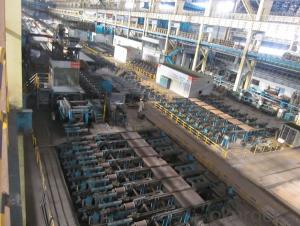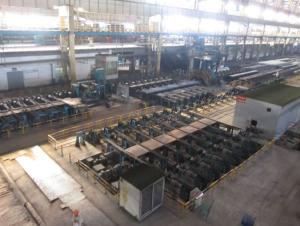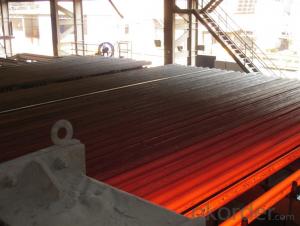Prime quality square alloy steel billet 95mm Q235
- Loading Port:
- Tianjin
- Payment Terms:
- TT OR LC
- Min Order Qty:
- 100 m.t.
- Supply Capability:
- 10000 m.t./month
OKorder Service Pledge
OKorder Financial Service
You Might Also Like
Structure of Prime quality square alloy steel billet 95mm Q235

Description of Prime quality square alloy steel billet 95mm Q235
1. Prepainted steel coil is coated with organic layer, which provides higher anti-corrosion property and a longer lifespan than that of galvanized or galvalume steel sheets.
2. The base metals for prepainted steel coil consist of cold rolled, HDGI Steel, electro-galvanized and hot-dip alu-zinc coated steel. The finish coats of prepainted steel coil can be classified into groups as follows: polyester, silicon modified polyesters, polyvinylidene fluoride, high-durability polyester, etc.
3. The production process has evolved from one-coating-and-one-baking to double-coating-and-double-baking, and even three-coating-and-three-baking.
4. The color of the prepainted steel coil has a very wide selection, like orange, cream-colored, dark sky blue, sea blue, bright red, brick red, ivory white, porcelain blue, etc.
5. The prepainted steel coils can also be classified into groups by their surface textures, namely regular prepainted sheets, embossed sheets and printed sheets.

Main Feature of Prime quality square alloy steel billet 95mm Q235
Uncoated CR steel sheet
With the features of in line with the international highest standards in demension and shape, excellent surface finish and properties, the products are mainly used in home appliance and automobile industries.
Galvanized steel sheet(include HDG and EG)
With the features of good corrosion resistance, the products are mainly used in automobile, home appliance, electronics, building and machinery manufacture industries, etc.
Precoated steel sheet
With the features of enviromental protection and good processablility, long lasting surface durability, rich in colors, the products are maily used in building, home appliance and furniture industries, etc.
Applications of Prime quality square alloy steel billet 95mm Q235
Construction
Manufacture anticorrosion, industrial and civil architecture roof boarding, roof grille
Light industries
Home appliance's case, civil chimney, kitchen utensils
Auto industry
Corrosion resistant parts of cars
Agriculture
Food storage, meat and aquatic products' freezing and processing equipment
Commerce
Equipments to store and transport materials, and packing implements

Specifications of Prime quality square alloy steel billet 95mm Q235
Product | Prime quality square alloy steel billet 95mm Q235 |
Material Grade | SGCC / SGCH / DX51D+AZ, etc |
Thickness | 0.6-3.0mm |
Width | 500-1500mm |
Tolerance | Thickness: +/-0.02mm , Width:+/-2mm |
Zinc-coating | Z30-150g/m2 |
Technique | Raw material: Hot rolled steel coil --> Cold rolled_>hot dipped galvalume |
Surface | Dried, Chromated, Unoiled |
Spangle | Regular spangle , small spangle, zero spangle |
ID | 508MM 610MM |
Coil weight | 1-25MT |
Export package | Cardboard inner sleeves, Waterproof paper, galvanized steel covered and steel strip packed |
FAQ of Prime quality square alloy steel billet 95mm Q235
We have organized several common questions for our clients,may help you sincerely:
1. How Can I Visit There?
Our company is located in Tianjin City, China, near Beijing. You can fly to Tianjin Airport Directly. All our clients, from home or aboard, are warmly welcome to visit us!
2. How Can I Get Some Sample?
We are honored to offer you sample.
3. Why choose CNBM?
Our delivery time about 15-20days for standard sizes, if you have other requirements like hardness, quanity and width ,it is about 20-40days. But don't worry we also try our best for the delivery time ,because time longer and our cost is higher.
- Q:How are steel billets used in the manufacturing of tooling?
- Steel billets are an essential component in the manufacturing of tooling. Tooling refers to the process of designing and creating tools that are used in various industries for cutting, shaping, or forming materials. Steel billets are semi-finished products that are cast from molten steel and then hot rolled into various shapes and sizes. In the manufacturing of tooling, steel billets serve as the raw material from which the tool is formed. These billets are usually made from high-quality steel alloys that exhibit excellent strength, durability, and wear resistance properties. These characteristics are crucial for tooling applications as they ensure the longevity and performance of the tools. Once the steel billets are obtained, they undergo a series of processes to transform them into tooling components. The first step is to heat the billets to a specific temperature, typically above the recrystallization temperature, which makes the steel more malleable and easier to shape. This process is known as hot working. After heating, the steel billets are shaped into the desired form through various techniques such as forging, extrusion, or rolling. These methods allow the steel to be molded into complex shapes, such as dies or molds, which are commonly used in tooling applications. The shaping process ensures that the tooling components have the necessary dimensions, surface finish, and structural integrity to perform their intended function. Once the tooling components are shaped, they may undergo additional heat treatments to further enhance their mechanical properties. Processes like tempering, annealing, or hardening are commonly used to modify the steel's hardness, toughness, and resistance to wear. These treatments increase the tooling's lifespan and improve its performance in demanding manufacturing environments. Overall, steel billets play a crucial role in the manufacturing of tooling by serving as the starting material for shaping tooling components. The high-quality steel used in billets provides the necessary strength and durability required for tooling applications. By shaping, heat treating, and finishing these billets, manufacturers can create tooling that meets the specific needs of various industries, enabling efficient and precise cutting, shaping, and forming of materials.
- Q:If the casting speed is not steady, what will happen to the billet?
- The instability of the casting speed leads to the unstable surface of the mould and increases the probability of slag entrapment in the mold.
- Q:What are the main factors affecting the quality of steel billets?
- The main factors affecting the quality of steel billets include the composition of the raw materials used, the temperature and duration of the heating process, the cooling rate, and the presence of impurities or defects in the final product. Additionally, the quality of the equipment and machinery used during the production process, as well as the expertise and experience of the workers, can also significantly impact the quality of steel billets.
- Q:What is the standard size of a steel billet?
- The specific requirements and industry standards may cause the standard size of a steel billet to fluctuate. Generally, these steel billets are rectangular and their dimensions usually fall within the range of 100mm x 100mm to 200mm x 200mm. The length of a steel billet also tends to vary, though it commonly measures approximately 6 meters. It is worth mentioning that these dimensions are not set in stone and can be tailored according to the intended usage and manufacturing procedure.
- Q:What are the different methods of surface inspection for steel billets?
- There are several methods of surface inspection for steel billets, including visual inspection, magnetic particle inspection, ultrasonic testing, eddy current testing, and dye penetrant testing. Visual inspection involves a thorough visual examination of the billet's surface to detect any visible defects or irregularities. Magnetic particle inspection uses magnetic fields and iron particles to identify surface cracks or defects. Ultrasonic testing uses high-frequency sound waves to detect internal and surface flaws in the billet. Eddy current testing uses electromagnetic induction to detect surface defects, while dye penetrant testing involves applying a colored dye to the surface and inspecting it for any indications of defects. These methods help ensure the quality and integrity of steel billets before further processing or use.
- Q:How do steel billets compare to other metal billets?
- Steel billets are frequently regarded as superior to other metal billets because of their distinctive properties and characteristics. One of the primary advantages of steel billets is their exceptional strength and durability. With a high tensile strength, steel is resistant to deformation and can withstand heavy loads and stresses. Furthermore, steel billets exhibit excellent thermal conductivity, enabling efficient heat transfer. This characteristic proves particularly advantageous in industries like construction and automotive, where effective heat dissipation is vital for optimal performance and longevity of the final product. Steel billets also boast a high melting point, enabling them to endure extreme temperatures without compromising their structural integrity. This makes them suitable for applications involving exposure to high heat, such as in furnaces or engines. Moreover, steel billets possess the ability to be easily formed and shaped into various sizes and dimensions, rendering them highly versatile for a wide array of applications. They can be rolled, forged, or extruded, allowing manufacturers to create diverse products tailored to specific requirements. Furthermore, steel billets possess excellent corrosion resistance, particularly when combined with protective coatings or treatments. This makes them ideal for outdoor applications or environments where they may come into contact with moisture or chemical substances. In terms of cost-effectiveness, steel billets are often more economical compared to other metal billets like aluminum or titanium. This is due to the abundant availability of iron ore, the primary component of steel, and the efficiency of steel production processes. In conclusion, steel billets possess a unique combination of strength, durability, thermal conductivity, versatility, and cost-effectiveness that distinguishes them from other metal billets. These qualities make steel billets highly sought after in a broad range of industries, including construction, automotive, manufacturing, and infrastructure development.
- Q:How are steel billets used in the production of agricultural implements?
- Steel billets are an essential component in the production of agricultural implements. These billets are typically used as raw materials that undergo various processes to form the final products required for agricultural activities. Firstly, steel billets are heated and then passed through a rolling mill to form different shapes and sizes. This process is called hot rolling. The resulting steel bars or rods are then further processed to produce specific agricultural implements such as plows, harrows, cultivators, and seed drills. During the manufacturing process, the steel billets are subjected to precise cutting, bending, and shaping techniques to create the desired implements. The strength and durability of steel make it a preferred choice for agricultural equipment, as it can withstand the demanding conditions encountered in the field, including soil resistance and impact from rocks and other obstacles. Steel billets are also used to manufacture components like blades, tines, and tips, which are crucial for the efficient functioning of agricultural machinery. These components are often hardened and tempered to enhance their wear resistance and toughness, ensuring that they can withstand heavy use without damage. Furthermore, steel billets are used for the production of attachments and accessories that can be used with the main agricultural implements. These attachments, such as plow points, disc blades, and planter plates, are designed to enhance the functionality and versatility of the equipment, allowing farmers to adapt to different soil conditions and crop requirements. In summary, steel billets play a vital role in the production of agricultural implements. Through various manufacturing processes, these billets are transformed into durable, reliable, and efficient tools that help farmers carry out their tasks effectively and efficiently, ultimately contributing to increased productivity in the agricultural sector.
- Q:What are the main factors that affect the competitiveness of steel billets manufacturers?
- The main factors that affect the competitiveness of steel billet manufacturers include cost of production, quality of products, technological advancements, availability of raw materials, economies of scale, market demand, pricing strategies, and competitiveness of rival manufacturers.
- Q:How do steel billets contribute to the manufacturing of consumer electronics?
- Steel billets are an essential raw material in the manufacturing of consumer electronics as they are used to produce various components and casings. These billets are melted and shaped into specific forms, such as sheets or bars, which are then used to construct frames, chassis, and other structural parts of electronic devices. The strength, durability, and malleability of steel make it an ideal material for ensuring the integrity and longevity of consumer electronics, thereby contributing to their overall quality and performance.
- Q:How are steel billets transported and stored?
- Steel billets are typically transported and stored in a careful and systematic manner to ensure their quality and safety. When it comes to transportation, steel billets are usually moved using trucks or railcars. Trucks are commonly used for short-distance transportation within a steel mill or between different facilities, while railcars are employed for longer distances, including intercity or even international transport. During transportation, steel billets are loaded onto the trucks or railcars using cranes or forklifts. It is crucial to secure the billets properly to prevent any movement or damage during transit. Straps, chains, or other securing methods are used to keep the billets in place and ensure their stability. Once the steel billets reach their destination, they are unloaded using similar lifting equipment. It is important to handle the billets with care during the unloading process to avoid any scratches or dents that could compromise their structural integrity. Regarding storage, steel billets are typically kept in designated areas called billet yards or billet storage facilities. These areas are designed to accommodate the size and weight of the billets and provide easy access for loading and unloading operations. Steel billets are often stored in stacks or piles, with each billet being carefully positioned to maintain stability and prevent any potential accidents. The billets may be organized based on various criteria, such as size, grade, or production date, to facilitate their retrieval when needed. To protect the billets from environmental factors, such as humidity or corrosion, they are often covered with protective coatings or stored in enclosed areas with controlled climate conditions. Additionally, regular inspections and maintenance are carried out to ensure the quality and integrity of the stored billets. Overall, proper transportation and storage procedures are essential to safeguard the steel billets and maintain their quality until they are ready for further processing or use in various industries.
1. Manufacturer Overview |
|
|---|---|
| Location | |
| Year Established | |
| Annual Output Value | |
| Main Markets | |
| Company Certifications | |
2. Manufacturer Certificates |
|
|---|---|
| a) Certification Name | |
| Range | |
| Reference | |
| Validity Period | |
3. Manufacturer Capability |
|
|---|---|
| a)Trade Capacity | |
| Nearest Port | |
| Export Percentage | |
| No.of Employees in Trade Department | |
| Language Spoken: | |
| b)Factory Information | |
| Factory Size: | |
| No. of Production Lines | |
| Contract Manufacturing | |
| Product Price Range | |
Send your message to us
Prime quality square alloy steel billet 95mm Q235
- Loading Port:
- Tianjin
- Payment Terms:
- TT OR LC
- Min Order Qty:
- 100 m.t.
- Supply Capability:
- 10000 m.t./month
OKorder Service Pledge
OKorder Financial Service
Similar products
New products
Hot products
Related keywords

































